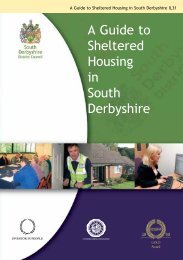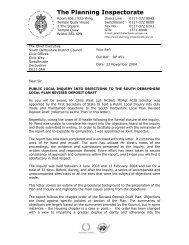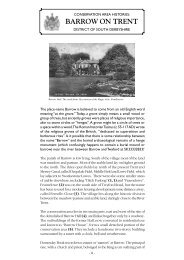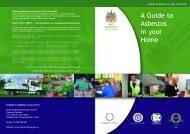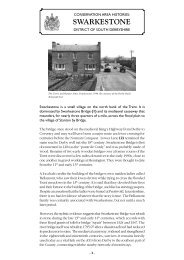Housing Strategy 2009-2014 - South Derbyshire District Council
Housing Strategy 2009-2014 - South Derbyshire District Council
Housing Strategy 2009-2014 - South Derbyshire District Council
Create successful ePaper yourself
Turn your PDF publications into a flip-book with our unique Google optimized e-Paper software.
<strong>South</strong> <strong>Derbyshire</strong> <strong>District</strong> <strong>Council</strong> <strong>Housing</strong> <strong>Strategy</strong> <strong>2009</strong> – <strong>2014</strong><br />
4.2 Consultation<br />
4.2.1 The <strong>Council</strong> consults regularly on developing its strategic approach with tenants,<br />
residents and partner organisations. In developing this strategy, the outcome of<br />
other consultations has also been considered. This includes development of the<br />
Homelessness <strong>Strategy</strong>, Community <strong>Strategy</strong> and Local Development Framework,<br />
as well as findings from ‘face to face’ research carried out to assess residents<br />
housing needs including specific research to consider the needs of the Black,<br />
Minority and Ethnic communities and Gypsy and Travellers.<br />
4.2.2 In addition to the above, wide-ranging consultation has been carried out in<br />
developing this strategy. This includes a special event held in January <strong>2009</strong> with<br />
stakeholders to specifically challenge the key issues identified by our research<br />
and to set the strategic housing direction for the district for the next 5-years. At this<br />
event stakeholders agreed that the current key housing issues are to meet the<br />
shortfall in affordable housing and to ensure that people can sustain their existing<br />
homes. These two issues were seen as the most significant issues to target limited<br />
resources. However, it was also widely acknowledged that they were probably the<br />
most challenging to address with the early <strong>2009</strong> economic slowdown. There was<br />
also concern from several housing providers that they are experiencing an increase<br />
in tenants involved in alcohol and substance misuse which may increase further as<br />
the recession starts to impact on household’s disposable incomes.<br />
4.3 Local Partnerships<br />
4.3.1 The <strong>Council</strong> has a Local Strategic Partnership that includes <strong>Derbyshire</strong> Police,<br />
<strong>Derbyshire</strong> County <strong>Council</strong>, Primary Care Trust, Community & Voluntary Sectors and<br />
local businesses. This partnership leads on delivery of the Sustainable Community<br />
<strong>Strategy</strong>. Joint working is not an end in itself but a means of helping facilitate the<br />
provision of appropriate services. <strong>Housing</strong> is only one area, which impacts on a vibrant<br />
economy. Bringing together partners and professionals from a range of organisations<br />
and backgrounds enables a holistic approach to promoting community well-being.<br />
4.3.2 Affordable housing is a key issue for this district. To build capacity to deliver rural<br />
housing the <strong>Council</strong> is a member of the Trent Valley Partnership, which brings<br />
together three Local Authorities and three Registered Social Landlords to improve<br />
delivery of rural affordable housing. As a key priority for this district the <strong>Council</strong><br />
contributed to the funding of a research post to access local housing needs.<br />
4.3.3 With a predicted increase in <strong>South</strong> <strong>Derbyshire</strong> of some 37% 7 between<br />
2005 – 2015 of the older population the <strong>Council</strong> recognises that it will need to<br />
work closely with its partners to meet the anticipated demand on services and<br />
supported accommodation. Hence the district is currently working in partnership<br />
7<br />
Source: Office for National Statistics, Sub-national population projections<br />
8<br />
Telecare is the continuous, automatic and remote monitoring of real time emergencies and lifestyle<br />
changes over time in order to manage the risks associated with independent living.<br />
12



